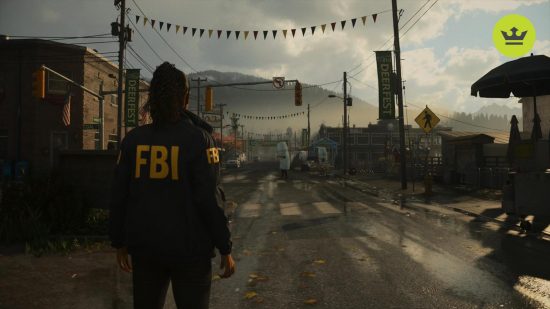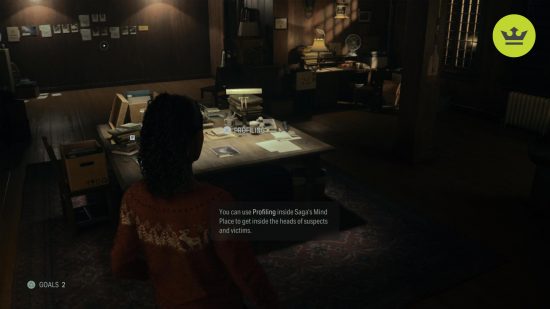Our Verdict
Alan Wake 2 packages captivating investigations and spine-tingling horrors into Remedy Entertainment’s most ambitious game so far. It's visually astounding, thematically potent, and an absolute must for newcomers and fans alike.
The gap between sequels can be a dangerous line to cross, especially when you’re dealing with something as beloved as the first Alan Wake game. Has the 13-year wait deflated any momentum that Alan’s initial story conjured up? After rolling credits on my Alan Wake 2 review playthrough, I can tell you the answer is a resounding ‘no’.
Remedy has taken time away to refine its formula with Quantum Break and Control, and Alan Wake 2 is not only the best game the studio has ever produced, but one of the best horror games of recent times.
Darkness, dirt, and death. Remedy opens up Alan Wake 2 with a blood-curdling reintroduction to the shores of Bright Falls, as you find yourself beyond broken, beaten, and scared. Cauldron Lake’s reflection mirrors its gorgeous mountain peaks within the water, beginning one of the more obvious allusions to Alan Wake 2’s focus on duality. Playing as neither newcomer Saga Anderson nor Wake, you wade through the forest in hopes of salvation, but it isn’t long before harrowing terrors turn the pouring rain to blood, setting up a goosebump-inducing title card. It all begins with a no-nonsense approach, affirming a sense of seriousness and brutality that would make its slightly softer predecessor squirm.
During my time at the Alan Wake 2 preview at Gamescom, Sam Lake said that David Lynch’s Twin Peaks is still very much the “bible” of inspiration for Alan Wake, and that notion sings as we meet FBI agent Saga Anderson for the first time. Echoing the pilot of Twin Peaks with an all-knowing nod, we’re examining a washed-up corpse, though this John Doe has suffered a demise far worse than Laura Palmer from the hit TV series. Picking up 13 years after Wake’s disappearance into The Dark Place, a twisted alternate dimension beneath the depths of Cauldron Lake, the lines between the two realms begin to become distorted. Wake is still trapped, desperately looking for salvation. He’s writing endless drafts of a new story, hoping its effect on The Dark Place can finally free him. Saga is brought to Bright Falls for a seemingly unrelated case at first but quickly finds that Wake is just the start of something far more sinister.

Ever since Max Payne, Remedy has continued to experiment with the relationship between cinematic media and the interactivity of gaming. The first two Max Payne games are filled with TV shows that poke fun at Remedy’s penchant for the bizarre, while Quantum Break and Control blend live-action footage into the experience. Alan Wake 2’s connective tissue weaves the two narrative threads together with bewitching results, perfectly sitting between cerebral cinema and enthralling gameplay. They serve each other, rather than one taking precedence over the other. Chapters end with gloomy songs speaking to the nature of loops, time, and mortality. And more importantly, the story is outright fantastic in itself. Though the game initially jumps between Saga and Wake’s perspective, you can eventually unlock the option to switch between their realities at will, by visiting specific Break Rooms around the game’s biomes.
You’re free to dedicate as much time as you wish to either, meaning you could continue a purely Saga or Wake playthrough until the endgame. The level of detail that lives and breathes in each campaign must have been a logistical nightmare to implement, but I’m in awe of how well it’s been done. Their plots manifest interchangeably in unexpected ways, often causing me to exclaim “holy shit” at my screen. It all manages to come across with a genuine sense of weight, but Remedy still manages to infuse plenty of laughs too. I won’t spoil the specifics, but make sure you check out the fourth Alan Wake-centric mission as soon as possible.
To get there though, Alan Wake 2 requires you to become the finest detective around first. Saga is an extremely proficient agent with a reputation for incredible deduction skills. My first foray with her intellectual prowess appears in the Mind Place, a separate hub that allows me to piece together individual clues and hunches about the case. This is where the web of intrigue begins to spin itself around me, and I gladly let myself become ensnared by it. You won’t be interrogating people like LA Noire, but the rush of figuring out goals, desires, and decidedly gut-churning motives is addictive. Clues, profiling, manuscript pieces, and discoveries in the world quickly fill up the Case Board, but Remedy doesn’t hold your hand while putting it all together. Multiple cases will quickly be stored in Saga’s filing cabinet, each of them interchangeable on the Case Board, with narrative threads often bleeding between each dossier.
Alan’s got his own version of the Mind Place too, known as the Writer’s Room. Instead of cases, Wake is on a mission to rewrite reality within The Dark Place, hoping to find an exit back to the real world. Accessing either of them is done in a literal instant, rivaling only a few new PS5 games like Spider-Man 2 when it comes to mind-blowing SSD trickery. It feels like witchcraft to watch the world around me evolve without a hitch, and The Dark Place is where Remedy truly flexes this tech, as multiple versions of the environment are accessible with a button press.
Speaking more generally about performance, Alan Wake 2 is excellent. During my playthrough, I encountered one enemy spawn in a slightly odd place and two very small frame drops, but outside of that, the experience was sublime. Performance Mode on PS5 runs at 60FPS, targeting a solid visual presentation of 2K resolution, while Quality Mode opts for 4K at 30FPS. Throughout my 16 hours with the game, I stayed with the 60FPS option, but Alan Wake 2 looks astounding regardless of your preference. Evolving on Remedy’s own Northlight engine once more, environments are soaked with detail, whether I’m walking over the mossy stones of Cauldron Lake or the litter-laden streets of New York City in The Dark Place. Raindrops subtly engage the DualSense’s haptic feedback, while tactile sound design places each drop on the leaves and skyscraper windows. All of it is adorned with impeccable lighting, striking a balance between gorgeous style choices and realism.
If it wasn’t for the looming threats that constantly haunt you, I’d happily stand basking in the warm glow of neon lights reflecting onto the rainy NYC pavement. These locations aren’t just linear levels, either. Leaning on Control’s sense of player freedom, the game’s narrative is split into different districts, all of which operate as an explorable hub with open-world style player agency.
It is a testament to how memorable Bright Falls was in 2010, as I easily found myself acquainted with familiar landmarks like the Bright Falls Sheriff Station or the Oh Deer Diner. Other areas like Watery dig deeper into the game’s True Detective influences, adding to the already immaculate vibes that Alan Wake 2 creates. The game’s atmosphere is trance-like, effortlessly shapeshifting between the macabre and brain-splitting surrealism. If you have a fear of being chased, then Alan Wake 2 will show no mercy in that regard. Or you can fight back with your intentionally limited arsenal.
The “scared, but cool” tone Sam Lake mentioned at Gamescom is present here, as weapons like the Flare Gun and the Sawn-Off Shotgun make me feel triumphant when I banish the surrounding darkness. Combat feels legions better than before, and will undoubtedly please fans of genre juggernauts like the recent Resident Evil remakes. Every shot matters and the tension of the adaptive triggers reinforces the crucial decision that each bullet amounts to. One missed shot, and it could be a grisly demise, as health can be chipped away within seconds. Weapon upgrades in the Mind Place are just as scarce as ammo, so finding safety in Break Rooms always made me exhale with relief.
Between these moments of respite, the game’s character writing shines bright. Alan Wake 2 is stacked with great performances, both from new and familiar faces. Matthew Porretta and Ilkka Villi’s dual performance knock it out of the park as Wake, standing tall alongside Melanie Liburd’s Saga. Bright Falls is teeming with all manner of absurd characters to meet, and they add their own mysteries to the game’s world greatly. Lake appears as FBI agent Alex Casey, but Max Payne voice actor James McCaffrey supplies his iconic line delivery for this character. Lake playfully messes with the game’s fourth wall, while familiar faces like Shawn Ashmore raise more questions about the Remedy Connected Universe. It is very alive in Alan Wake 2, and RCU lore fanatics will have a field day putting it together.

Alan Wake 2 is an exemplary example of confidently delivering a sequel that adds valuable contributions to the survival horror genre. Delivering an expertly executed story that will leave you stunned by its ambition and boldness, Alan Wake 2 backs it all up with a remarkable gameplay experience that I’d happily jump back into immediately after rolling credits. It is easily one of the greatest horror games of the last decade, and pending those Max Payne remakes, it is the greatest game Remedy has made yet.














